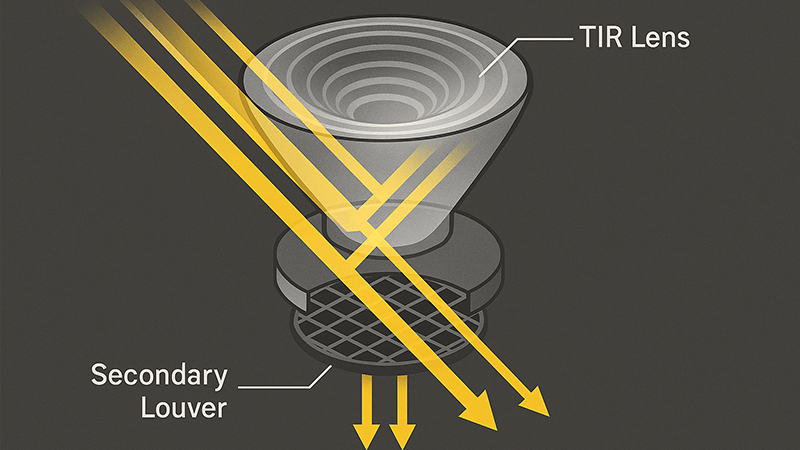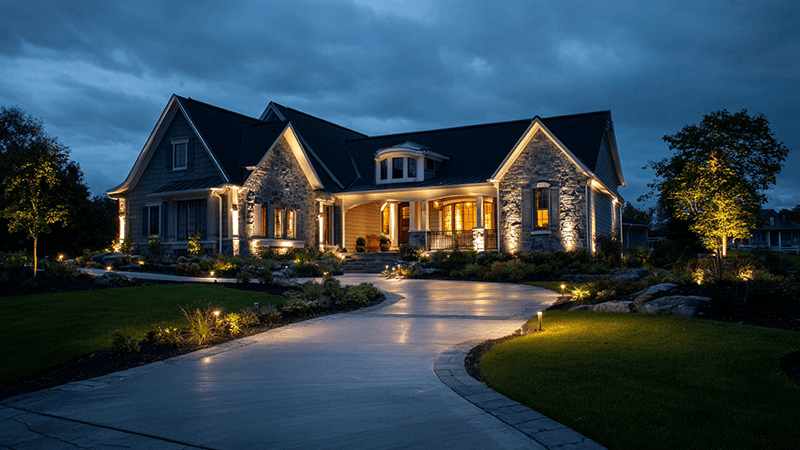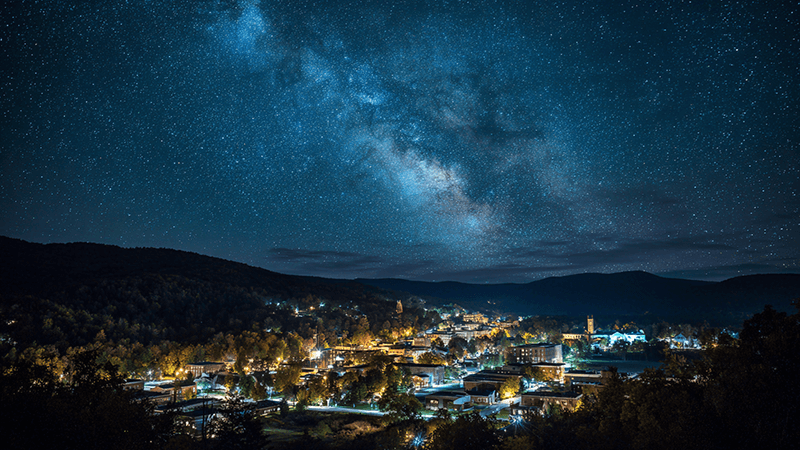Seeing light spill everywhere, wasting energy and annoying neighbors? The solution isn’t less light, but smarter light. The secret lies in using the right optic lenses.
Optic lenses play a crucial role by precisely controlling the direction and shape of light. They ensure light only goes where it’s needed, preventing it from escaping upwards into the sky or sideways into neighboring properties. This minimizes glare, skyglow, and light trespass.

It’s amazing how a small piece of plastic or glass can make such a big difference. I’ve seen it firsthand in my years in the lighting industry. Many people think "brighter is better," but that’s a huge misconception. The real magic isn’t in the power of the LED chip, but in how we guide its light. To truly understand this, we need to break down what these lenses actually do. Let’s explore how these precise optical tools are our best weapon against light pollution.
What is the purpose of optical lenses?
Ever wonder why some lights create beautiful, focused beams while others just produce harsh glare? The difference isn’t the bulb. It’s the powerful, often overlooked, optical lens.
The primary purpose of an optical lens in a luminaire is to collect the light produced by the LED and redirect it. It shapes the light into a specific beam pattern, like a narrow spot or a wide flood, ensuring maximum light reaches the target area efficiently.

In my experience, the lens is the most critical component for light quality. Think of an LED chip as a bare light bulb. It throws light out in many directions. Without a lens, most of that light is wasted. An optical lens acts like a director for that light. Its first job is to collect as much of the light as possible and focus it. Its second, more important job is to shape that light into a useful beam. This is where beam angles come in. If you need to light a tall, thin tree, you need a narrow beam angle of about 10 degrees. If you want to illuminate a wide building wall, you need a wide flood beam of 60 degrees or more. The problem is that many users and even some sellers have a "wider is better" mentality. They choose a wide-angle lens for every application, thinking it covers more ground. The result is massive light spill. The light bleeds past the target, onto the street, into a neighbor’s window, and up into the sky. This wasted light is pollution. I remember a client, a purchasing manager named Shaz from the UAE, who was frustrated with samples that created terrible glare for a new project. We showed him a fixture with a proper "full cut-off" design, where precise optics directed all light downwards. He was amazed at how it lit the pathways perfectly without blinding anyone. That is the power of good lens design.
| Feature |
Without Proper Lens |
With Proper Lens |
| Light Direction |
Scattered, uncontrolled |
Focused, precise |
| Efficiency |
Low, light is wasted |
High, light on target |
| Glare |
High |
Minimal |
| Light Pollution |
Significant |
Greatly reduced |
What is the role of lenses in the study of light and optics?
The world of optics has complex terms. This can be confusing when specifying products. But understanding a few key designs reveals how we can precisely control light.
In lighting design, lenses are essential tools. They use principles like refraction and total internal reflection (TIR) to control light. Secondary optics, like louvers or honeycomb grids, are added to further refine the beam, cut glare, and minimize spill light for maximum precision.

When we talk about optics in LED lighting, it’s not just about a single lens. We often use a system. The first part is the primary optic, usually a Total Internal Reflection (TIR) lens. This lens sits directly over the LED chip and is incredibly efficient at capturing light and aiming it in a general direction. But for true precision, we need the next step: secondary optics. Think of these as accessories that provide fine-tuning. These can be honeycomb-patterned grids, baffles, or louvers that sit in front of the primary lens. Their job is to cut off any stray light at the edges of the beam, especially light that would cause glare at high angles.
Here is a critical point for any purchasing manager. These secondary optics can reduce the total measured light output by 10% to 20%. Many manufacturers know this. To make their products look better on a specification sheet, they leave these components out. They sacrifice light quality to boast a higher lumen number. I’ve had many discussions with clients who are pressured to buy the product with the highest lumens for the cheapest price. I always ask them: where are those lumens going? If 20% of that light is creating glare and another 20% is lighting up the night sky, you are paying for pollution. A fixture with slightly lower lumens but excellent secondary optics is a much better long-term investment. It puts the light you paid for exactly where you need it.
How can you reduce the effects of light pollution on you?
Is a neighbor’s security light shining into your bedroom? This frustrating light trespass is a common problem. You can fight back by making smart choices with your own lighting.
Reduce light pollution by choosing fully shielded, "full cut-off" fixtures. Use the lowest wattage necessary for the task, select a precise beam angle to match your target, and aim lights carefully downward. Also, consider using warm-colored light (under 3000K) to minimize environmental impact.

Reducing your own light pollution comes down to a few key strategies, and optics are central to all of them. The first and most important strategy is to only purchase "full cut-off" or "fully shielded" fixtures. This means the design of the fixture and its internal optics prevent any light from escaping above a horizontal line from the fixture. You should never be able to see the bare bulb or LED chip from the side. This simple design choice almost single-handedly prevents skyglow. The second strategy is to match the beam angle to the job. Don’t fall into the trap of using a wide beam for everything. It’s like using a fire hose to water a single flower pot. You must be disciplined. Use a narrow beam for a column, a medium beam for a shrub, and a wide beam for a wall. This precision ensures light isn’t wasted. The final strategy is to challenge the "more is brighter" myth. I often see projects where a few huge, high-power "cannon" style floodlights are used to blast an area with light. Contractors sometimes prefer this because it means fewer installation points. However, this method creates terrible glare, harsh shadows, and significant light pollution. A much better approach is to use a larger number of low-power fixtures. For example, instead of two 150W floodlights for a small lot, use ten well-placed 30W fixtures. The lighting will be more uniform, more pleasant, and far less polluting.
| Target |
Recommended Beam Angle |
Why? |
| Tall, thin tree / Flagpole |
Narrow (10-15°) |
Concentrates light vertically, avoids spill. |
| Building Façade |
Wide (45-60°) |
Evenly washes a large, flat surface. |
| Pathway |
Asymmetric |
Pushes light forward and down the path. |
Why do you think it is important to reduce your own light pollution?
Does light pollution feel like someone else’s problem? It’s easy to think one more light doesn’t matter. But the collective impact starts with individual choices, affecting everyone.
Reducing your own light pollution is important for several reasons. It saves energy and money, improves safety by reducing dangerous glare, respects your neighbors by preventing light trespass, and protects nocturnal ecosystems. It demonstrates responsibility and a commitment to a healthier community.

The reasons for controlling light pollution are very practical, especially from a business perspective. First, there are direct cost savings. Every photon that shoots up into the sky is wasted electricity you or your client paid for. By using precise optics to put light only where it’s needed, you can often use lower-wattage fixtures to achieve the same or better effect. I have helped clients reduce their outdoor lighting energy use by over 50% just by upgrading to fixtures with superior optical control. Over a project’s lifetime, these savings are enormous. Second, it improves real safety and security. There’s a misconception that brighter is safer. In reality, intense, glaring light creates deep shadows that can hide threats. It also temporarily blinds people, making them more vulnerable. Well-directed, uniform light without glare improves visibility for everyone. Third, it is about being a good neighbor and protecting a project’s reputation. Light trespass is a major source of complaints. When your project’s security lighting shines into a residential building, it creates problems. Specifying responsible lighting from the start prevents these conflicts. As someone who has built a lighting business, I feel a great responsibility to offer solutions that improve our world. We can have safe, beautiful, well-lit spaces without destroying the night. The technology is here; it’s just a matter of making the right choice.
Conclusion
Ultimately, fighting light pollution isn’t about using less light, but using it wisely. The right optical lens is our most powerful tool to achieve this, saving energy and preserving our skies.